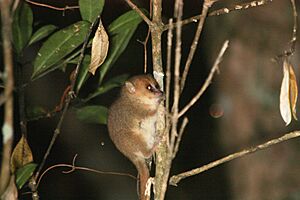Goodman's mouse lemur facts for kids
Quick facts for kids Goodman's mouse lemur |
|
|---|---|
 |
|
| Conservation status | |
| Scientific classification | |
 |
|
| Distribution of M. lehilahytsara |
The Goodman's mouse lemur (Microcebus lehilahytsara) is a tiny mouse lemur that lives in eastern Madagascar. You can find them near a place called Andasibe. This special lemur is named after a scientist who studies primates, Steven M. Goodman. Its Malagasy name, "Lehilahytsara," means "good man."
Scientists announced the discovery of Goodman's mouse lemur on August 10, 2005. At the same time, they also shared news about another new species, the northern giant mouse lemur. In 2005, Steven M. Goodman received a special award called a MacArthur Fellowship for his amazing discoveries and research in Madagascar.
Contents
What Does Goodman's Mouse Lemur Look Like?
Mouse lemurs are some of the smallest primates in the world. Goodman's mouse lemur is no different! It's not the absolute smallest, but its body size is very similar to the smallest known primate.
These lemurs usually weigh about 45 to 48 grams. That's like weighing a few strawberries! Male lemurs are often a little bit bigger than females. Goodman's mouse lemurs have a beautiful maroon (dark reddish-brown) fur color. Their bellies are white, and their backs have a slight orange tint.
How Do They Survive the Cold?
Goodman's mouse lemurs have a clever way to save energy. They can go into a deep sleep called torpor. They do this every day, and also for longer periods in winter. Think of it like a mini-hibernation! Their tails are very useful because they can store fat there. This stored fat gives them energy during their winter torpor.
Most female lemurs go into winter torpor every year. However, not all males do. The males who do go into torpor usually wake up about 20 days before the females. This gives them time to get ready for the mating season. Older male lemurs often skip winter torpor. This might help them compete better for mates against younger males. Even if they don't have a long winter sleep, they still go into daily torpor.
Social Life and Behavior
Goodman's mouse lemurs usually spend most of their time alone when they are awake. They are mostly seen with another lemur during mating season or when they are fighting. About half of their fights are about food!
Even though female lemurs are usually smaller than males, they often win fights over food. This is because female Goodman's mouse lemurs are more dominant than the males. Because females are in charge, males often have to search for food in a much larger area. Sometimes, a male's feeding area can be four times bigger than a female's! Scientists think this might be because the dominant females chase the males away from the best feeding spots.
Sleeping Together for Warmth
Not all social interactions are about fighting. Sometimes, groups of two to four lemurs of the same sex will sleep together. This is a smart way to stay warm! When female lemurs share a sleeping spot, they are usually related to each other. However, male lemurs who sleep together often aren't related.
During the spring, after they wake up from winter torpor, males and females come together for the mating season. It's a time when they need to get along peacefully. During this time, male Goodman's mouse lemurs are known to weigh more than the females. At other times of the year, their weight can change depending on the season and the environment.
Family Tree of Mouse Lemurs
The group of animals called Microcebus (which includes all mouse lemurs) started to develop into different species about 9 to 10 million years ago. This led to many different types of mouse lemurs. They split into three main groups.
Goodman's mouse lemur belongs to a group with five other species. Scientists figured this out by looking at their DNA. About 540,000 years ago, one species called M. marohita split off from the others in this group. The most recent split happened about 52,000 years ago. That's when Goodman's mouse lemur (M. lehilahytsara) and M. mittermeieri became two separate species.
How Climate Change Shaped Them
This recent split into new species happened around a time when the climate changed a lot. Scientists believe that this climate change made the central highlands of Eastern Madagascar much drier. This change in climate and habitat likely caused the new species to form.
One piece of evidence for this is that Goodman's mouse lemur lives in a habitat that doesn't overlap with any other mouse lemurs. The environment changed in a way that only the lemurs who would become Goodman's mouse lemur could survive there. These lemurs have a varied diet, eating insects, fruits, flowers, nectar, gum, and leaves. Their bodies are also very adaptable, with their metabolism, body temperature, and body mass changing with the seasons and environment.
Images for kids




